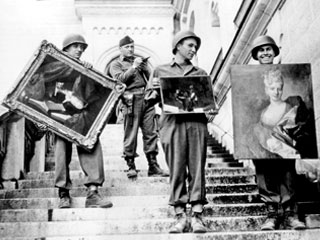The Rape of Europa
by Geoff Kelly
Raiders of the Lost Art
In 1938, Ferdinand Bloch-Bauer, a wealthy Viennese Jew and a patron of modernist painter Gustav Klimt, fled Austria to Switzerland to escape the Nazis. Bloch-Bauer’s massive art collection, including Klimt’s portraits of his wife Adele, was subsequently seized, along with the rest of his property and his considerable financial interests.

His is one of many similar stories told in Rape of Europa, a moving and informative documentary that tracks the Nazis systematic pillaging of Europe’s private and public art collections, the patrimony of the nations and people that fell before Germany’s advancing armies. The film, based on the book of the same title by Lynn H. Nicholas, takes us on a journey across Europe’s cultural landscape, under threat of falling bombs and pillage: to Paris, where the contents of the Louvre are secreted away to country chalets before the city’s fall, and where the collections of affluent Jewish collectors like the Rothschilds are stolen wholesale (as well as, eventually, their furniture, carpets, dishware, and clothes); to Leningrad, where the Hermitage’s staff wait out the siege in the museum’s basements, where the collection has been moved for protection; to the Allied advance through Italy, where a special squad of US art experts do what little they can to protect the country’s art and architecture from destruction.
But the destruction of art and architecture, though well documented in this film, takes second place to theft in the story it tells. It is estimated that the Nazis stole one fifth of Europe’s fine art over the course of the Second World War. Some of this theft represented private plunder, but most was state-sponsored and programmatic. In the case of dispossessed Jewish art collectors, the theft was part of a campaign to erase completely an entire’s people’s footprint on the continent.
Luftwaffe commander Hermann Goering was an especially rapacious thief, according to the film, stealing thousands of paintings, sculptures, tapestries, and other art objects, and collecting them in a gaudy hunting lodge in the Bavarian Alps. (His collection of European art there outstripped that of the National Gallery in Washington, DC.) Goering apparently planned his acquisitions well in advance of military action: According to the daughter of a prominent Jewish collector in Paris, Goering visited her father’s gallery before the war began. Her father threw Goering out on the street. “He knew what he was trying to do,” the daughter recalls in the film. One historian notes, in fact, that Hitler’s invasion plans were always accompanied by catalogs of significant cultural objects in the path of invasion and orders for securing those that Hitler coveted. The historian seems to stop just short of asserting that these catalogs may have preceded—possibly even motivated—Hitler’s invasions.
Watch the trailer for "The Rape of Europa"
In contrast to Goering’s louche and mercenary pursuit of valuable art, Hitler’s obsession is presented as a symptom of his own perverted artistic sensibilities; much is made of his frustrated career as a painter, and of his anger upon failing to gain admittance to the Vienna Fine Arts Academy after the First World War. Couple this with overarching ambition for Germany: As the Thousand-Year Reich crumbles around him, the Russian and American armies pushing relentlessly toward Berlin, Hitler continued to refine his plans for the construction of a magnificent museum in his hometown of Linz, Austria, which he envisions as repository for all the cultural wealth of the Reich and of humanity—or at least that part of humanity whose art was deemed worthy of collection and exhibition.
The Linz Museum was never built, of course, and Hitler’s art collection was discovered after the war in a mineshaft. Many pieces lost during the war remain lost; others, like Bloch-Bauer’s Klimts, have been sold and resold and wound up in public collections. The Klimts landed in the national collection of Austria, whose government fought his descendants for their possession. In 2006, however, a panel of Austrian judges granted possession of five paintings by Klimt to Maria Altman, Bloch-Bauer’s 90-year-old niece.
The film suggests that similar resolutions may become more and more common in the future; lost artworks long held secretly by private collectors will surface at auction houses, as those collectors die and their heirs, unaware of the provenance, show them light of day once more.
blog comments powered by Disqus
|
Issue Navigation> Issue Index > v7n25: Who's Sorry Now (6/19/08) > Film Reviews > The Rape of Europa This Week's Issue • Artvoice Daily • Artvoice TV • Events Calendar • Classifieds |









 Current Issue
Current Issue